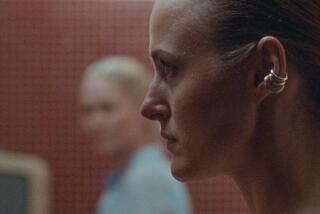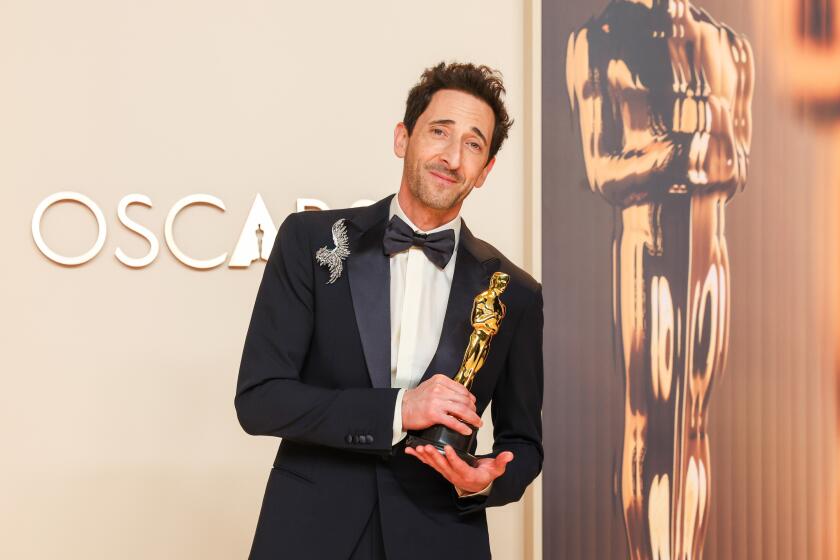Estonia’s long-gestating ‘Truth and Justice’ reveals universal, personal struggles
- Share via
Author A.H. Tammsaare is hardly a household name in North America, but in Estonia he’s one of the nation’s most prominent literary figures. If American high school students are reading John Steinbeck’s ”The Grapes of Wrath” or “Romeo and Juliet,” then Estonian teenagers are dreading the text of Tammsaare’s challenging “Truth and Justice, Part One.”
Somehow, filmmaker Tanel Toom found a way to avoid tackling it. That lack of familiarity with it became something of an embarrassment for him, however, and he spent the next decade slowly deciphering its universal themes.
“During that time, I had already graduated from two film schools. I’d gone to the army. I was more mature and had some kind of life experience when I finally read it,” Toom says. “And thank God that it happened [that way]. That I wasn’t ruining this book for myself when I was 17 because I know that if I would have read it then, I would have never ever understood it.”
It took Toom, an Oscar nominee in 2011 for his live-action short, “The Confession,” a full year to figure out how to map out the structure of the novel in screenplay form.
Tammsaare’s initial 1926 novel centers on Andres (Priit Loog in the film), a 19th-century landowner of a large, struggling farm known as Robber’s Rise. For decades, he bickers with his neighbor in the court of law and pushes his wife and farmhands to work nonstop. He becomes so hardened in his obsessions with protecting the land and battling his rival that he eventually drives his entire family away.
“What really affected me was how contemporary the struggles of the characters of the novels were,” Toom says. “And how it’s kind of related to my own journey of let’s say, self-fulfillment. I mean, it’s a very common thing to mostly kind of suppress your feelings and not express what’s inside you. And it’s an especially very Estonian thing to do.”
Once he’d found the film’s structure, it took four years to complete the script and three more to get it to the screen. It was quite a difficult process because, as Toom describes it, the narrative is very episodic and doesn’t have a clear focus: “There are chapters that go off completely from the main stories.”
The production itself proved almost as challenging as adapting Tammsaare’s opus. Because the story takes place over 24 years, Toom felt it necessary to shoot the picture during all four seasons. In his view, soundstages or digital work simply wouldn’t do with Robber’s Rise being so much a part of the film.
Some of those seasons would have the initial layout of Robber’s Rise in Andres’ early years and then the larger compound over a decade later. That forced Toom, his production team and his acting ensemble to film the movie over a whopping year and a half. But the shoot itself? Just 75 days of filming during that long period.
“The days were really packed, and it was actually very good to have these five or seven periods of shooting so there’s space in between,” Toom says. “You kind of have better control rather than being knackered by the end of 73 [straight] days. If it’s at one time then you might start doing stupid things.”
The actors were mostly well-known theater veterans in Estonia, but the production was so long that actress Maiken Schmidt, who plays Andres’ first wife, pretended to be pregnant in some early scenes only to shoot others while actually pregnant months later.
That was a minor issue compared with Toom’s biggest challenge. A majority of the picture is filmed outside and what plagued the shooting schedule was, of course, the weather.
“It suddenly starts to snow in the middle of spring and you’re like waiting,” Toom recalls. “It’s probably not going to last for long, but you’re still losing hours. The winter thing was especially tricky. Although there are people who are saying that there is no climate change, in Estonia we always clearly had four different seasons. But now, it’s really changing and winter is coming later and later and some years there’s no snow at all. And the year we were shooting, the snow didn’t come. We had to postpone the winter shoot twice because of that.”
The years of commitment paid off. Not only did “Truth and Justice” become the highest-grossing Estonian film in history, but it made the shortlist for the 2020 international feature film Academy Award. That was a sweet reward for the months, perhaps years, of what Toom describes as feeling like a “squirrel running in a wheel.”
“It’s impossible to predict,” Toom says of the positive reaction he’s received from the film. “Estonians, the media and everyone were really aware of the movie because it took such a long time. And when we were casting and finding out who the actors were, of course like every single Estonian has an opinion of how this film should be made because it’s based on that book — although not that many Estonians had actually read that book.
“But yeah, I was very much ready to get beat [down]. And so, as a director, you’re always taking that risk.”
“Truth and Justice” now has a 50-50 chance of becoming just the second Estonian film nominated for an Academy Award after Zaza Urushadze’s “Tangerines” in 2015. Whatever the outcome, the 37-year-old director is looking to tackle something completely different for his next feature, a post-apocalyptic drama set in the ocean.
“Working in this creative field, that there has to be this possibility of failure, that makes me tick and work harder,” Toom says. “The higher the stakes, the more you push yourself and then the happier you will be in the end if you succeed.”
More to Read
Only good movies
Get the Indie Focus newsletter, Mark Olsen's weekly guide to the world of cinema.
You may occasionally receive promotional content from the Los Angeles Times.










